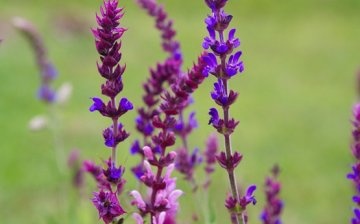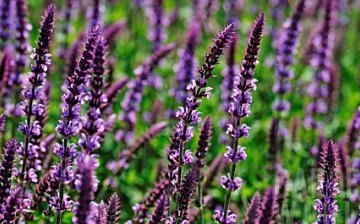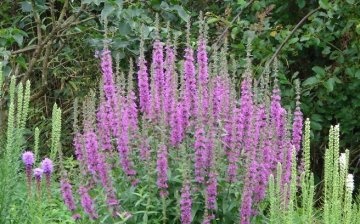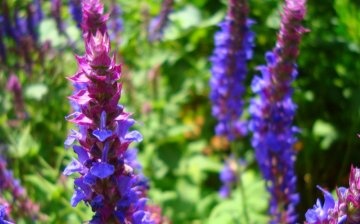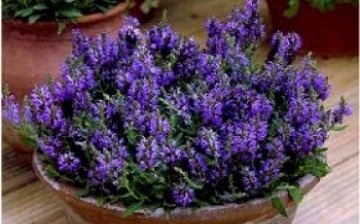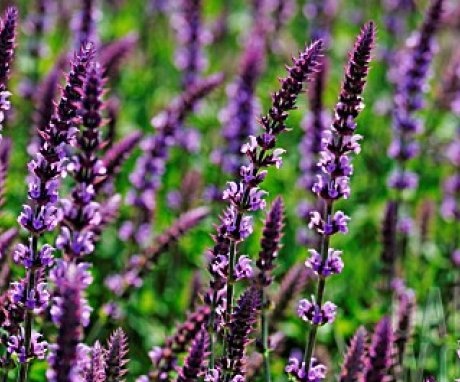Salvia Dubravnaya: characteristics, varieties, care and reproduction of the plant
Salvia, more familiar by its name sage, is a herbaceous shrub. There are annual and perennial representatives. In a decorative form, mainly annuals are grown, but perennial shrubs can often be found in dachas and personal plots.
Content:
- General information about Salvia Dubravna
- Salvia varieties
- Salvia care
- Reproduction of Salvia Dubravnaya
- The use of salvia dubravna
General information about Salvia Dubravna
Plant characteristic:
- Its branches are high, reaching 120 cm.
- The leaves are large, elliptical, ribbed, pointed at the ends.
- The flowers are collected in inflorescences and are colored in red, purple, violet, white or purple tones.
- Plants are unpretentious. Perennial species are frost-resistant, can withstand cold weather with a drop in temperature to -18 degrees.
Salvia oakgrass is grown as a perennial plant.
Today there are Salvia about 700 species... Of all types, it is considered the easiest to care for and frost-resistant. In the wild, it can be found in the foothills of the Crimea, on the European territory of Russia, in the Caucasus. It is also found in some places in Central Asia and Siberia. Salvia grows along river banks and on mountain slopes.
This is not the tallest species of sage, the length of straight branches can reach only 60 cm. They are strongly branched and pubescent. The leaves in the lower part of the branches are large, oblong, glabrous, pointed at the ends. At the top, the leaves are much smaller. Inflorescences are long, up to 40 cm. The flowering period lasts all summer.
Salvia varieties
Description of Salivia varieties:
- Lilac meadow. This variety of oak salvia is very easy to grow in the garden. She is unpretentious in care, very blooms beautifully and magnificently... The branches reach a height of 60 cm. The flowers are painted in a blue-violet tone. Winters well and is not susceptible to disease.
- Pink glade. This bush has inflorescences of a pale pink color, which are located on branches, 60 cm long. The variety is unpretentious in care, flowering is long and abundant. The variety is not susceptible to disease and tolerates cold well.
- Adora blue. The small bush reaches a height of only 40 cm. The branches are erect, well branched. Blooms profusely and for a long period. The buds are located on long inflorescences, the petals are bright blue. After sowing seeds in spring, the plant will bloom in the first year.
- Ost Friesland. Shrub, the height of which reaches 60 cm. Branches are erect, strongly branching. Blooms profusely throughout the summer. The inflorescences are located at the ends of the branches, thick and lush. The petals are purple. It has a high decorative effect, since during flowering it is completely covered with buds and forms a purple bush.
- Viola Close. The bush is up to 50 cm high, compact. The stems branch, the leaves from the lower part are large and have a pleasant aroma. Blooms from late June to late August. The flowers are dark blue-violet. Can withstand severe frosts.
- Blaukoningin. This is one of the undersized varieties of oak salvia. The bush grows only 30 cm. Inflorescences up to 20 cm with small blue flowers. It blooms from early summer to early autumn.Leaves are medium in size, oblong, located on petioles. In the upper part of the branches, the leaves are small, sessile.
- Purple Queen. The bush is 60 cm high. It blooms in a bright purple tone, the inflorescences are up to 30 cm long, dense. This variety blooms only in the second year after sowing the seeds. The leaves are large, dark green in color, and have a pleasant aroma.
- Plumosa. This variety of oak salvia has beautiful and atypical flowering for this species. The flowers are collected in relatively short, but very dense inflorescences, up to 20 cm long. The petals are painted in bright purple color. A bush of medium height, up to 60 cm, very decorative. The leaves are large. The stems are highly branched.
- Marcus. The height of this variety is only 20 cm. It is usually planted as a ground cover plant. It blooms profusely and for a long time. The buds are collected in inflorescences, which occupy almost the entire part of the stem. The color of the petals is blue-violet.
- Caradonna. Herbaceous perennial shrub 45 cm high. Stems are straight, branching, slightly pubescent. Blooms almost all summer. The buds are collected in long loose inflorescences. The color is violet blue.
Salvia care
Almost all types and varieties of sage are unpretentious to care and are resistant to parasites and diseases. All varieties and species are very similar in terms of growing conditions.
Salvia likes regular watering, but it does not tolerate stagnant water, therefore, in a wet and rainy summer, it is worth observing the condition of the soil near the bush.
The plant is pruned annually in the fall:
- Dry branches are removed and the main ones are cut off. This is done so that the bush does not stretch and more shoots are formed for the density of the bush.
- Also, wilted inflorescences are removed during the summer. Since salvia blooms for a long period, this process also lasts all this time.
Insulation is required only for those varieties that do not tolerate frost. To do this, at the end of October, the rhizome of the bush is covered with compost and leaves. Some varieties, especially thermophilic ones, are dug up for the winter and transferred to the basement or cellar for the winter.
In some cases, plants are attacked by mites.
This is noticeable by the appearance of brown spots on the leaves. This problem is easily solved with the help of drugs that can be bought at any store for amateur gardeners.
Reproduction of Salvia Dubravnaya
Reproduction of Salvia Dubravnaya a fairly simple process. This can be done in four ways: air layering, cuttings, dividing the bush, and seeds.
When propagating by air layers, it is necessary to secure the adult branch to the ground, for example, with an iron bracket. With regular watering of the bush, roots will soon appear at the layer. When the daughter plant is finally rooted, it can be cut off from the mother bush and transplanted to a new place.
Reproduction by cuttings can be carried out from mid-spring to early autumn.
For this, branches are selected on an adult bush, which are already a little stiff. Cuttings are made from them, which, after cutting, must be placed in a container with water, deepening the cut parts. After 2-3 weeks, the roots will already appear. After that, you need to wait another week, the roots will grow and you can transplant the plant into the ground. The division of the bush can be done during the spring transplant, if required.
Salvia grows easily, including with the help of air layers. This happens when the branches on their own for various reasons lie on the ground for a long time. The bush is divided into the required number of parts and planted in new places.
Reproduction by seeds:
- When propagating by seeds, you should be more careful and careful.
- You can sow seedlings right into the ground before winter, and in the spring the seedlings can already be planted in a permanent place.
- But this method may not give results, since the seeds will not survive the winter for various reasons.
- It is recommended to carry out this process in the spring and at home and plant ready-made strong and healthy seedlings in the beds.
- For this, fertile soil is poured into a small box, into which the seeds are sown. They must be regularly watered and monitored so that the water does not stagnate, as this can lead to rotting of seeds or seedlings.
- When the sprouts have a pair of adult leaves, they must be dived.
- For the initial transplant, small pots are suitable, in which it is necessary to plant one plant at a time.
In this form, sage is waiting for the first days of summer, when it will already be possible plant young plants into the ground. When planting a plant, you should carefully choose a site. The place should be well lit by the sun. Salvia prefers soil that is sandy and fertile, loose and well-drained. Another important point when planting different varieties of sage. This plant crosses easily, so it is best for different varieties to choose different places on the site or in the garden.
The use of salvia dubravna
Salvia wide applied in landscape design... A large number of varieties, with a variety of flower colors, allows designers to use it to decorate gardens, flower beds and parks. Another advantage of this plant is that the bushes come in different sizes in height, and the formation and thickening of the branches is quick and easy.
Salvia is also often planted in decorative pots and decorated with gazebos and verandas.
Salvia takes root well with any plants, so it can be combined and matched in color, getting the desired result and bright, spectacular design solutions.
Salvia is also a medicinal plant. And if you translate its Latin name into Russian, you get the word "save". And it’s not just that. This plant helps with many diseases.
Sage is widely used in folk medicine.
Of course, this is not the case for all species. Its leaves are harvested and harvested during the flowering period. To do this, they are separated from the stem and dried under the sun. Since ancient times, salvia was considered a female flower, as its broth helps with several ailments. For example, in case of infertility, it was recommended to drink a sage decoction, which strengthened the walls of the uterus and increased the likelihood of conceiving a child. He also helped with inflammatory processes in the female reproductive organs.
Since ancient times, sage leaves have been used as a disinfectant:
- His decoctions helped with various diseases... Over time, the use of this plant has only increased. This plant is also a component in many medicines.
- Salvia leaves can be brewed like tea. It is very useful as a prophylactic against colds or as a remedy for colds.
More information can be found in the video.



